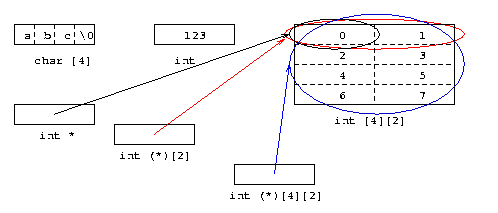By far the best way to understand all this is to examine a diagram of
several actual objects. Here is one such diagram, in which our C
system has at least six objects. One of these objects is an array
of four
chars, or as I prefer to
say, has type ‘array 4 of char’.
This array holds a string, "abc". Another is an ordinary int
that is set to 123. These two objects are just floating around uselessly
in this diagram so as to clutter it up.![]() They are the same size, suggesting that this implementation has sizeof(int)==4.
They are the same size, suggesting that this implementation has sizeof(int)==4.
The remaining four objects are the important ones. The largest box (in black) is an object of type ‘array 4 of array 2 of int’, or int [4][2]. Its elements are initialized to values counting up from 0 to 7. There are also three pointers, and each one has a different type.

void f(void) {
int matrix[4][2] = { {0,1}, {2,3}, {4,5}, {6,7} };
char s[] = "abc";
int i = 123;
int *p1 = &matrix[0][0];
int (*p2)[2] = &matrix[0];
int (*p3)[4][2] = &matrix;
/* code goes here */
}
These differences affect the results of both pointer arithmetic and the unary * (indirection) operator. Since p1 points to a single int, p1 + 1 moves forward by a single int. The black circle[1] is only as big as one int, and *(p1 + 1) is just the next int, whose value is 1. Likewise, sizeof *p1 is just sizeof(int) (probably 4).
Since p2 points to an entire ‘array 2 of int’, however, p2 + 1 will move forward by one such array. The result would be a pointer pointing to a red circle going around the {2,3} pair. Since the result of an indirection operator is an object, *(p2 + 1) is that entire array object, which may fall under The Rule. If it does fall under The Rule, the object will become instead a pointer to its first element, i.e., the int currently holding 2. If it does not fall under The Rule -- for instance, in sizeof *(p2 + 1), which puts the object in object context -- it will remain the entire array object. This means that sizeof *(p2 + 1) (and sizeof *p2 as well, of course) is sizeof(int[2]) (probably 8).
Finally, p3 points to the whole matrix, and p3 + 1 will move forward by one whole matrix. This would be a blue circle around something that is not even there. ANSI C allows you to calculate such a pointer, but not to use it with an indirection[2] . Since *(p3 + 1) is itself an error, it is probably best just to note that *p3 is the entire matrix, and thus sizeof *p3 is sizeof(int [4][2]), or 4*2*sizeof(int) -- in this case, most likely 32 (since sizeof(int) looks like 4 in the diagram above).